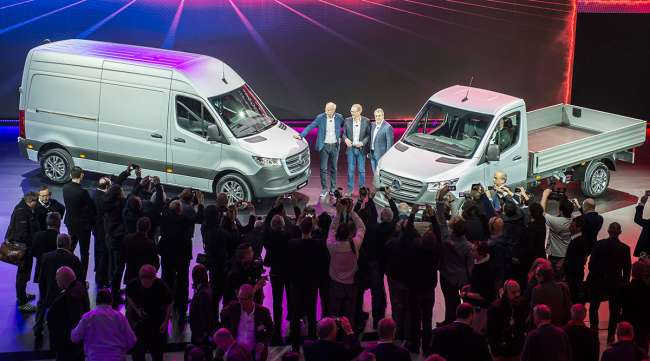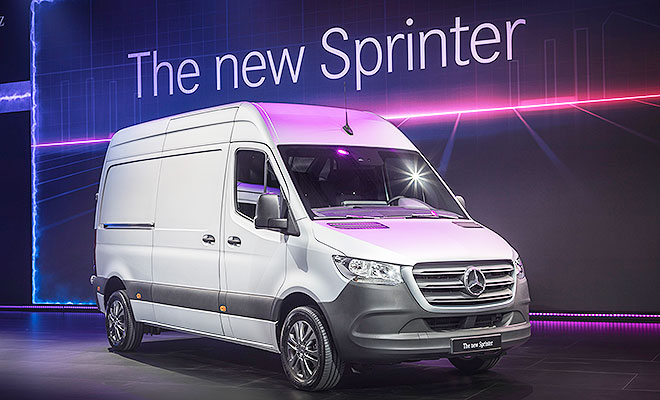Managing Editor, Features and Multimedia
Mercedes-Benz Debuts New Sprinter Van

DUISBURG, Germany — Mercedes-Benz has revealed its new Sprinter, a digitally connected, highly versatile vehicle that can be customized to fit a diverse range of applications, from last-mile delivery to construction work to passenger transport.
The third generation of the company’s flagship commercial van made its first public appearance here Feb. 6 at the home of the world’s largest inland port.
Beyond its updated exterior, the new Sprinter comes with a host of internet-enabled services.
“We want to offer the customer the best possible, tailor-made overall package. And these days that means, above all, the right combination of hardware and software,” said Dieter Zetsche, chairman of Mercedes-Benz parent Daimler AG.
The new Sprinter will utilize Mercedes Pro, a suite of connected-vehicle services designed to improve fleet management and driver productivity.
The new Sprinter also will be the company’s second vehicle to offer the new Mercedes-Benz User Experience, or MBUX, a redesigned infotainment system and digital assistant.
The new Sprinter’s integrated technology makes it “the first van of a whole new species,” said Volker Mornhinweg, head of Mercedes-Benz Vans.
“We’re making the new Sprinter into a piece of smart hardware — into a node in the internet of things,” he said. “The new communications module means the vehicle is constantly connected to the internet.”
#NewSprinter #MBVans pic.twitter.com/FVQhiwpqV3 — Seth Clevenger (@SethClevenger) February 6, 2018
The updated Sprinter also expands the model’s trademark versatility.
With eight different body variants and more options for powertrains, wheelbases, roof heights and more, the new Sprinter will be available in more than 1,700 configurations worldwide.
“There has never, ever been this much flexibility,” Mornhinweg said.
Mercedes-Benz plans to launch the new Sprinter in the United States by the end of this year. The vehicle will be available with both diesel and gasoline engine options.
Mercedes-Benz also showcased an all-electric version of the van, but has not yet announced firm plans for U.S. availability.
Most of the new Sprinters ordered by U.S. customers will be built at a new $500 million factory in Charleston, S.C., although some variants will continue to be made in Germany.
By shifting much of its manufacturing to the United States, Mercedes-Benz is poised to reduce the time and cost of producing the Sprinter for this market.
Currently, the company goes through a time-consuming process of partially disassembling Sprinters built in Germany before shipping them to the United States, then reassembling them in South Carolina to bypass a 25% tariff on imported cargo vans.

The new Sprinter will be available in 1,700 variations for a diverse range of applications. (Mercedes-Benz)
Mercedes-Benz also highlighted the new Sprinter’s safety technology.
The vehicle offers driver-assistance systems that are comparable to those now offered on premium passenger cars. These capabilities include active lane-keeping assist, active braking assist, adaptive cruise control and crosswind assist.
Other safety features include a self-cleaning rear-view camera, a parking assistance system with a 360-degree camera and a new windshield wiper system aimed at improving visibility.
Meanwhile, customers will be able to utilize a range of networked services through Mercedes Pro, which Mornhinweg described as the “operating system” for the Sprinter hardware.
Fleet managers will be able to use the system to communicate with drivers, manage work assignments online and remotely check vehicle information such as fuel level and maintenance intervals.
The company also plans to offer a mobile app that will provide drivers with features such as paperless work records and remote access to vehicle information.
Volker Mornhinweg: #NewSprinter will be available in 1,700 variants. “This kind of flexibility is unprecedented.” #MBVans @mbusa pic.twitter.com/U1Nx8rM8W4 — Seth Clevenger (@SethClevenger) February 6, 2018
Other tools will be available through the MBUX driver interface.
Users can access the internet via voice command to quickly find weather information, fueling locations or nearby places to eat. The platform also incorporates artificial intelligence to learn and offer suggestions based on the user’s habits.
The MBUX navigation software uses the “what3words” global geocoding system, which maps out the world into trillions of 3-by-3-meter segments and assigns a three-word address to each. With that three-word code, the system can guide the driver to very precise locations, including places not easily found through a simple address, such as a small section of a large construction site or a specific utility pole in a remote area.
With its updated Sprinter, Mercedes-Benz is seeking to build on its sales momentum in the large van segment.
Worldwide Sprinter sales rose 12% to 400,000 units in 2017, a fourth straight record year, Mornhinweg said.
Mercedes-Benz began producing the original Sprinter in 1995 and first brought the vehicle to the United States in 2001, which introduced the U.S. market to the large European-style cargo van.
Today, the Sprinter is sold under both the Mercedes-Benz and Freightliner brands. Of the 289 Sprinter dealers in the United States, 247 are Mercedes-Benz dealers and the remainder sell Freightliners.




